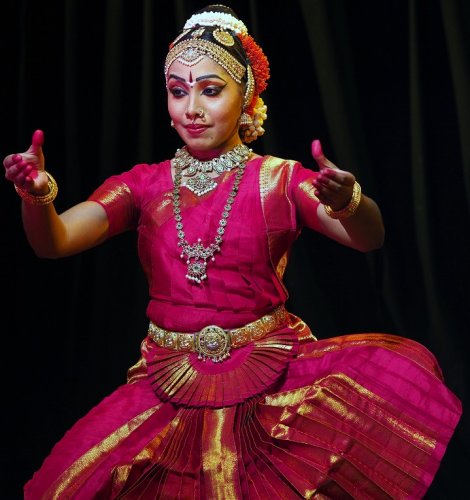 |
 Follow us       |
 |
 Follow us       |
 Snavaja Krishnan: A Margam of artistic excellence - Satish Suri e-mail: satishsm@yahoo.co.in Photo: Krishnamurthy May 10, 2019 The Bharatanatyam performance by Snavaja Krishnan under the aegis of the Indian Council for Cultural Relations marked a high level of competence. Tutored by her Guru Shilpa Nanjappa, a senior student of Padmini Ramachandran, Snavaja imbibed every nuance, be it the technique, or the execution of the adavus and teermanams to perfection. From the word go, the artiste made her presence felt in every aspect of the grammar and idiom of the genre. The invocatory Pusphanjali composed by Guru Padmini Ramachandran and the Ganesh Stuthi, that followed, which detailed how Ganesha received the elephant head from Shiva showcased the proficiency of the artist. The varnam in Poorvi Kalyani, a composition of K.N.Dandayudhapani Pillai "Swamiye vara solladi, sakhiye" showed her exemplary command over the technique infusing the imaginative choreography with emotional content sustained by pure dance interludes. The song depicts the nayika cajoling her sakhi to fetch her Lord Muruga for whom she is pining. The manifestation of Lord Muruga, whose praises are sung by the whole world conjured up a dream-like atmosphere, and his traits described through detailed sancharis. The sanchari depicting Muruga telling Lord Shiva about the significance and meaning of "OM" wherein Shiva switches to role of a devotee as per the command of his son was absorbing in its execution. The dramatization of the agony of the nayika suffering from the arrows of Cupid and vacillating between a state of delirium and wakefulness and unable to bear the separation, closing with a poignant entreaty to the sakhi to bring her Lord, was profound. The jathis sparkled with speed and grace and description of the subtle intricacies and nuances were evocative and precise. The inspired singing of Srivatsa added to the mood and ably supported by her Guru Shilpa Nanjappa on the nattuvangam, Harsha Samaga on the mridangam and Vivek Krishna on the flute added colour to the overall impact of the performance. The Devarnama "Adhigo Baruthidhane," a composition by Yoga Narasimha, describes how Rama wins the hand of Sita in the Sita Swayamvaram. The presence of Ravana adds to the palpable anxiety of Sita. The artist displayed a flair for capturing the fleeting expressions and changing moods of Sita. The composition of Papanasam Sivan in Khamas, "Idathu padam thooki aadum" was an absorbing piece about the cosmic dancer Nataraja through a balance of freezes and nritta sequences. The choreography provided for contrasting description of Nataraja's accessories set against the vigorous dancing steps. Snavaja followed it with a Telugu padam "Indhendu vachitivira" showing a khandita nayika angered at the wayward ways of her lord -'You have come to the wrong street; the other woman is in another; even in the bright moonlight, you don't seem to know the way. Go away.' The artist portrayed effectively the emotions of the nayika and the inherent sarcasm bringing out the bhava with clarity that blended well with the sahitya. Snavaja concluded with a thillana in Mohana Kalyani, a composition by the Late Padmini Ramachandran, providing joy with crisp geometry and deft footwork, effective freezes and fluidity of rendition. Snavaja's performance left an indelible imprint on the artistic template of Late Guru Padmini Ramachandran, a legacy nurtured and fostered by her students. Bangalore based Satish Suri is an avid dance rasika besides being a life member of the Music and Arts Society. |